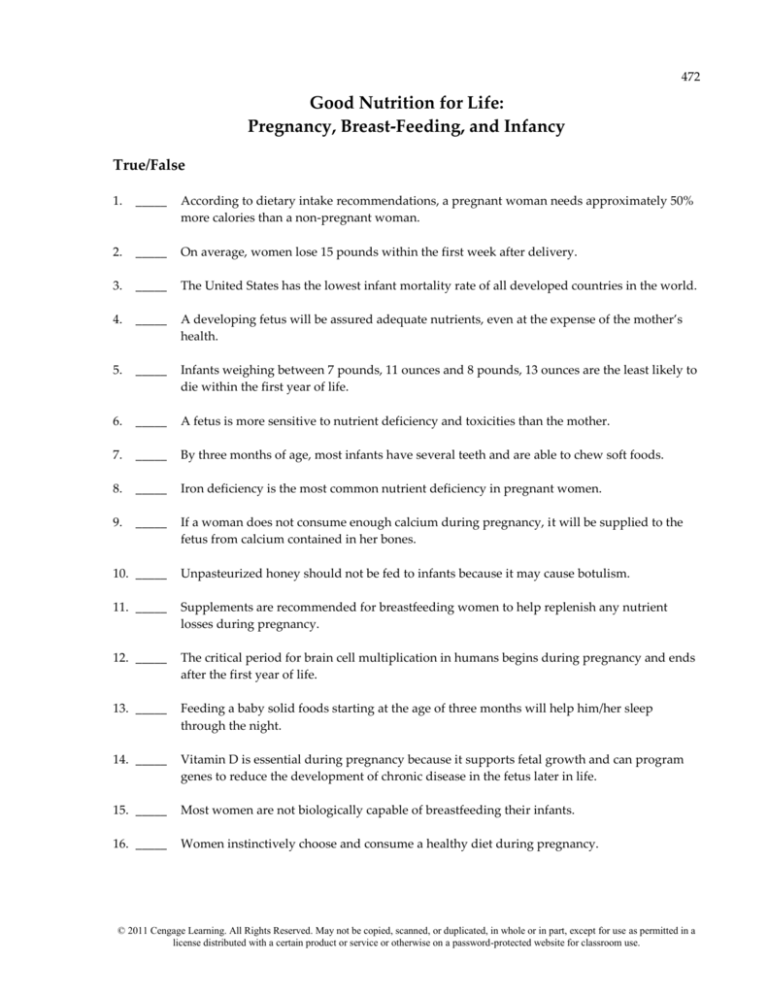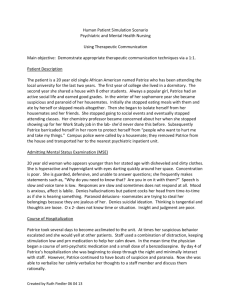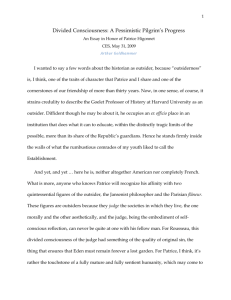
472
Good Nutrition for Life:
Pregnancy, Breast-Feeding, and Infancy
True/False
1.
_____
According to dietary intake recommendations, a pregnant woman needs approximately 50%
more calories than a non-pregnant woman.
2.
_____
On average, women lose 15 pounds within the first week after delivery.
3.
_____
The United States has the lowest infant mortality rate of all developed countries in the world.
4.
_____
A developing fetus will be assured adequate nutrients, even at the expense of the mother’s
health.
5.
_____
Infants weighing between 7 pounds, 11 ounces and 8 pounds, 13 ounces are the least likely to
die within the first year of life.
6.
_____
A fetus is more sensitive to nutrient deficiency and toxicities than the mother.
7.
_____
By three months of age, most infants have several teeth and are able to chew soft foods.
8.
_____
Iron deficiency is the most common nutrient deficiency in pregnant women.
9.
_____
If a woman does not consume enough calcium during pregnancy, it will be supplied to the
fetus from calcium contained in her bones.
10. _____
Unpasteurized honey should not be fed to infants because it may cause botulism.
11. _____
Supplements are recommended for breastfeeding women to help replenish any nutrient
losses during pregnancy.
12. _____
The critical period for brain cell multiplication in humans begins during pregnancy and ends
after the first year of life.
13. _____
Feeding a baby solid foods starting at the age of three months will help him/her sleep
through the night.
14. _____
Vitamin D is essential during pregnancy because it supports fetal growth and can program
genes to reduce the development of chronic disease in the fetus later in life.
15. _____
Most women are not biologically capable of breastfeeding their infants.
16. _____
Women instinctively choose and consume a healthy diet during pregnancy.
© 2011 Cengage Learning. All Rights Reserved. May not be copied, scanned, or duplicated, in whole or in part, except for use as permitted in a
license distributed with a certain product or service or otherwise on a password-protected website for classroom use.
473
Fill in the Blank
1.
The first breast milk produced after childbirth, which is richer in protein, minerals, and antibodies
than “mature milk,” is called _______________.
2.
An interval of time during fetal growth and development when tissue or organ cells are genetically
programmed to multiply is called a _______________.
3.
The normal duration of a pregnancy is divided into thirds, which are termed _______________.
Matching:
Match the term with its definition.
1.
_____
colostrum
2.
_____
critical period
3.
_____
development
4.
_____
preterm infant
5.
_____
fetus
6.
_____
growth
7.
_____
trimester
8.
_____
neural tube defects
9.
_____
low-birth weight infant
a.
a baby in the womb from the eighth week of pregnancy until
birth
b. processes involved in enhancing functional capabilities of the
body and mind
c. a process characterized by increases in cell number and size
d. infant born at or before 37 weeks gestation
e. a specific interval of time during which cells of a tissue or
organ are genetically programmed to multiply
f. one-third of the normal duration of pregnancy
g. malformations of the spinal cord and brain
h. the milk produced during the first few days after delivery
i. infant weighing less than 5.5 lb at birth
Case Study and Multiple-Choice Questions: Choose the one best answer.
Patrice is a first-time mother who is newly pregnant. She and her husband Seth are excited about their
new baby on the way. Patrice is a small-framed woman who, based on her doctor’s BMI charts, is
categorized as underweight. Patrice is also an elite swimmer and runner. She has been working out for the
majority of her adult life. Patrice and Seth are both very aware of the importance of good nutrition and
the role it plays in health and quality of life. However, they are both unsure of nutrition
recommendations for pregnancy and want to provide the best nutrition possible for the new baby.
Answer the following questions to help Patrice and Seth understand the nutrition recommendations for
pregnancy and infancy.
1.
How much weight should Patrice plan to gain during her pregnancy?
a. 15 – 25 lb
b. 24 – 35 lb
c. 28 – 40 lb
d. 45 – 55 lb
© 2011 Cengage Learning. All Rights Reserved. May not be copied, scanned, or duplicated, in whole or in part, except for use as permitted in a
license distributed with a certain product or service or otherwise on a password-protected website for classroom use.
474
2.
What specific nutrient is of particular importance pre-pregnancy and in the early stages of fetal
development?
a. Protein
b. Fat
c. Folate
d. Iron
3.
What should Patrice do for exercise during her pregnancy?
a. Patrice should stop exercising for the duration of her pregnancy.
b. Patrice should continue to exercise at her normal intensity after she confirms with her doctor that
her routine is safe.
c. Patrice should stop running and only walk and swim.
d. Patrice should take up yoga and stop swimming and running.
4.
Patrice and Seth both follow a very healthy eating plan. Regardless of their good nutrition, what
specific nutrient might Patrice need to supplement during the second and third trimester?
a. Zinc
b. Calcium
c. Iron
d. Folate
5.
Patrice and Seth want to know if there are any particular nutrients that will help maximize their
fetus’s metal development. Which of the following nutrients is linked to higher levels of intelligence
in infants?
a. EPH and DHA omega-3 fatty acids
b. Calcium
c. Vitamin B6
d. Folate
6.
Patrice is a coffee drinker and enjoys having two cups of coffee in the morning with breakfast. During
pregnancy and breastfeeding, what should she do about her coffee drinking?
a. Stop drinking coffee or other caffeinated beverages
b. Continue to enjoy her coffee at her current level of intake
c. Cut her coffee consumption in half
d. Only drink decaffeinated coffee and tea
7.
After their baby is born, how should Patrice and Seth plan to feed their baby?
a. Breastfeed or feed their baby iron-fortified infant formula for the first 6 months of life
b. Breastfeed for 3 months and then start the infant on iron-fortified rice cereal
c. Introduce sweetened juice at 4 months
d. Breastfeed for the first three months and then switch to whole cow’s milk until 12 months
© 2011 Cengage Learning. All Rights Reserved. May not be copied, scanned, or duplicated, in whole or in part, except for use as permitted in a
license distributed with a certain product or service or otherwise on a password-protected website for classroom use.









